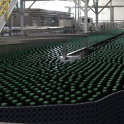|
Jo3sh posted:I account for their mass when doing temperature calculations, and I add them to the tun before the grain with the hope that they will be distributed toward the bottom of the grain bed. I'm a long way from doing anything beyong kit batches I think... but knowledge is knowledge.. What do you mean you account during calculations? Edit: Oh God new page: A picture from my first ever home brew, a Caribou Slobber (full size is GIANT) 
Capt. Sticl fucked around with this message at 20:24 on Feb 18, 2014 |
|
|
|

|
| # ? May 11, 2024 21:14 |
|
Capt. Sticl posted:I'm a long way from doing anything beyong kit batches I think... but knowledge is knowledge.. What do you mean you account during calculations? I believe he means that when you are trying to calculate strike water temp or change the temp of your mash you need to include the mass of rice hulls along with the rest of your grain.
|
|
|
|
Jo3sh posted:A pound in the grist for a five-gallon batch has always worked for me. I account for their mass when doing temperature calculations, and I add them to the tun before the grain with the hope that they will be distributed toward the bottom of the grain bed. Trying to get rice hulls at the bottom that way is both impossible if you stir anywhere near enough during water additions, and non ideal since the gummyness adds resistance throughout and hulls are supposed to give a backbone for the solution to give up the wheaty bits and catch a path down to where you need it. I've always heard to add them with your final addition, although earlier might make it was easier to stir for the same reasons it makes it drain. Alternatively my buddy did a protein rest over the weekend on a >50% wheat beer and it ended up more fluid than all my normal mashes like some sort of magic.
|
|
|
|
Thufir posted:I believe he means that when you are trying to calculate strike water temp or change the temp of your mash you need to include the mass of rice hulls along with the rest of your grain. Yeah, that. Basically, I have a spreadsheet that I use to calculate my water temperatures and volumes. The idea is that, in my rig, if I want to have a mash settle at x temperature, I mix together volume a of water at b temperature and weight q of grain at r temperature. When doing these calculations, I have to include the weight of the rice hulls in q - but of course, they have 0 potential extract and don't affect the gravity of the beer, so I leave them out of those calculations.
|
|
|
|
zedprime posted:Trying to get rice hulls at the bottom that way is both impossible if you stir anywhere near enough during water additions, and non ideal since the gummyness adds resistance throughout and hulls are supposed to give a backbone for the solution to give up the wheaty bits and catch a path down to where you need it. Yeah, they do always seem to end up evenly distributed, which I guess means the mash gets stirred enough. But that's what I have done anyway.
|
|
|
|
Catastrophe posted:Behold the toilet wine: I'm doing a personal experiment with toilet wines, since I got the "Spike Your Juice" kit you mentioned for Christmas. So far, here are my results: Bottom line for all of these is to taste daily. Once it gets where you like it, refrigerate and drink quickly. It's only a day room temperature between too sweet and too dry, and it's only a week in the fridge before something tasty becomes something bland.  Tart and sweet, with very little alcohol taste. Excellent all on its own at 4.8% ABV, though I added a half-cup of lemon juice for balance. I drank this happily during and after dinner!  Delicious but only if stopped very sweet. Past that, there's a hot alcohol taste. Might be a good mixer for a punch. Once it developed the harsh alcohols, it mixed well with orange juice.  Satan's anus. Terrible flavors and aromas all throughout. I gave it an extra month to try and let the aromas off-gas, but it never got better. Any requests? I have an apple juice ready to go that I'll start Friday so I can take it to an event Tuesday, but I'm willing to try others too.
|
|
|
|
I'm doing an Ocean Spray Cranberry lovely wine batch as a starter for some Skeeter Pee. Pitched a packet of Montrachet, I'm hoping it'll build up enough yeast to get a good slurry for the lemon juice.
|
|
|
|
more falafel please posted:Is there a time after which it's too late to plant hops? I'm in Chicago, and I'm moving into a new house in mid-April. I could plant pretty much immediately after that, and it's probably going to be no more than 4 weeks after last frost. I have no way of testing the AA but they were pretty mild. The centennial was okish but the cascade was downright undetectable in a finished brew. First year hops though. I didn't do anything to take care of them other than fertilizer once every two months (hey, I forgot, ok?) and fretting about something that was eating holes in the leaves early on. My advice is to make sure where you plant them is where you want them forever. An armadillo has been digging in the beds recently and I can see those tiny rhizomes are almost spilling out of the 2x6ft raised planter I made for them. I mean it is insane how dense the root system is now and I bet this year they're going to swallow my house. Once they're in for a year, you're never going to be able to move them without a giant excavation. EDIT: Moneyshot. July 16th CapnBry fucked around with this message at 02:14 on Feb 19, 2014 |
|
|
|
Got my first Bree going and so far so good. I'm amazed by how easy the entire process is. Fermented is going good and it's smelling great. I did get a carboy to do a 2nd stage. Any easy way to tell when I should syphon it over? Also, any tips on cleaning bottle? I've saved a bunch but they aren't the cleanes. Looking around it seems like working in oxiclean and then sanitizing is a good way to go?
|
|
|
|
Harminoff posted:Got my first Bree going and so far so good. I'm amazed by how easy the entire process is. Fermented is going good and it's smelling great. If they are of questionable cleanliness oxiclean soak is a decent way to get out any gunk. The easiest way is to rinse out while everything's still wet from the last beverage that was contained and store. Either rinse again before sanitizing to get the dust out, or use enough sanitizer that you're comfortable its getting the dust out before it is sanitizing (as opposed to just spritzing with enough to wet the surface).
|
|
|
|
Thank you. What's the reason behind not using a secondary?
|
|
|
|
Harminoff posted:Thank you. What's the reason behind not using a secondary? The benefit doesn't generally outweigh the risk of oxidation and infection from moving your beer.
|
|
|
|
Who here has set up a closed-loop system for use with a wort chiller? Is it worth it? I'm trying to reduce my water waste.
|
|
|
|
illcendiary posted:Who here has set up a closed-loop system for use with a wort chiller? Is it worth it? I'm trying to reduce my water waste. I tried it for a while. It takes about 10 pounds of ice for every gallon of wort you want to bring to pitching temp from a boil. It turned out not to be worth it for me.
|
|
|
|
Harminoff posted:Thank you. What's the reason behind not using a secondary? I secondary only when I'm making additions, like cocoa nibs or dry hopping. I always cold crash and rack off when bottling/kegging though.
|
|
|
|
zedprime posted:The easiest way is to rinse out while everything's still wet from the last beverage that was contained and store. Either rinse again before sanitizing to get the dust out, or use enough sanitizer that you're comfortable its getting the dust out before it is sanitizing (as opposed to just spritzing with enough to wet the surface). If you store bottles upside down in six pack carriers you don't have to worry about dust getting in the bottles post rinse. Just make sure they're dry first so you don't weaken the carrier.
|
|
|
|
Midorka posted:I secondary only when I'm making additions, like cocoa nibs or dry hopping. I always cold crash and rack off when bottling/kegging though. Oh snap, i just dry hopped an Irish Red in primary. I know there are lots of differing opinions about using secondary at all, but can you explain why you use it for dry hopping, just so I have something to look out for/worry about*? It's been in primary for eight days and gone from 1.049-1.011, so I'm confident that fermentation is complete, although it does have some clearing to do. *Totally not gonna worry about it. I'm past that point with this brew. Just curious.
|
|
|
Skitz posted:Oh snap, i just dry hopped an Irish Red in primary. I know there are lots of differing opinions about using secondary at all, but can you explain why you use it for dry hopping, just so I have something to look out for/worry about*? It's been in primary for eight days and gone from 1.049-1.011, so I'm confident that fermentation is complete, although it does have some clearing to do. Dry hopping in primary will make most the hoppyness that you would get from dry hopping scrub off in the c02 because of the main ferment. The only drawback from dryhopping in secondary is sometimes you might get a grassy / oily taste and or smell. I've never had that though. Byo did a good article on it here: http://byo.com/stories/issue/item/569-dry-hopping-techniques quote:The secondary fermenter is generally considered the best place for dry hopping for a couple of reasons. First, the beer has already mostly fermented so, as mentioned above, the alcohol and low pH helps to ward off any bacteria on the un-sanitized hops. Second, the vigorous CO2 activity of the primary is finished, so the aroma of the hops won�t be scrubbed out of the beer. Fluo fucked around with this message at 08:04 on Feb 19, 2014 |
|
|
|
|
Fluo posted:Dry hopping in primary will make most the hoppyness that you would get from dry hopping scrub off in the c02 because of the main ferment. The only drawback from dryhopping in secondary is sometimes you might get a grassy / oily taste and or smell. I've never had that though. All you have to do is wait until the main fermentation is over... that article is very old fashioned. Secondary is a waste of time unless you are working with a beer where freshness isn't an issue and/or you want to add some stuff to it.
|
|
|
Glottis posted:All you have to do is wait until the main fermentation is over... that article is very old fashioned. Secondary is a waste of time unless you are working with a beer where freshness isn't an issue and/or you want to add some stuff to it. I'm confused, I'm saying dry hopping in secondary is better then dry hopping in primary (which it is, since in primary most the hop aroma is scrubbed off with the co2). I don't move any of my beer to secondary unless I am adding something eg: for my coffee porter I transfered the beer ontop of my cold extracted coffee. If you're saying add the dry hops into primary after ferment that seems abit risky, specially with carboys where the hops would cause splashing when you dropped them in.
|
|
|
|
|
Fluo posted:I'm confused, I'm saying dry hopping in secondary is better then dry hopping in primary (which it is, since in primary most the hop aroma is scrubbed off with the co2). I don't move any of my beer to secondary unless I am adding something eg: for my coffee porter I transfered the beer ontop of my cold extracted coffee. When you pop the cap off of that carboy it will be filled with beer and heavier-than-o2 co2. Pop the top and drop the hop. You won't introduce any oxygen unless you're actively loving with it.
|
|
|
Paladine_PSoT posted:When you pop the cap off of that carboy it will be filled with beer and heavier-than-o2 co2. Pop the top and drop the hop. You won't introduce any oxygen unless you're actively loving with it. I understand what you're saying but I still think the splashing is a bad idea of dropping the pellets in? I don't know I just think its not worth the worry.  Edit: gently caress it, I've got an American Pale at the end of primary at the moment I'll give it a shot and compare it with the in secondary on the hops one.  One in secondary is on Nelson Sauvin. Don't want to dry hop with the same hop as that one, got some spare Citra will have a go with that. 
Fluo fucked around with this message at 10:29 on Feb 19, 2014 |
|
|
|
|
Fluo posted:I understand what you're saying but I still think the splashing is a bad idea of dropping the pellets in? I don't know I just think its not worth the worry. All the splashing will do is potentially introduce stagnant CO2 from your headspace into the beer, which is where it came from and which is already saturated with 1 volume of CO2. Any O2 that chases it in will be utterly negligible.
|
|
|
Paladine_PSoT posted:All the splashing will do is potentially introduce stagnant CO2 from your headspace into the beer, which is where it came from and which is already saturated with 1 volume of CO2. Any O2 that chases it in will be utterly negligible. Ah ok gotcha, I'm guess I'm just always a bit anal when it comes to splashing and such because god drat all that work to go down the toilet from it splashing. Half the batch of my second ever brew had oxidized because of splashing* and since then been a bit anal about it. *Was lifting up the carboy so I could siphon it into the bottling bucket but when carrying it someone opened the door I was behind and made me drop it (lucky it didn't break). Also that beer taste book recommended in this thread turned up yesterday and has gave me some ideas for my 12th brew. Fluo fucked around with this message at 10:35 on Feb 19, 2014 |
|
|
|
|
Hey homebrew thread, long time no see. Wanted to stop by to see if any goons had plans on going to the AHA's National Homebrewing Conference this year, which happens to be going on in my old hometown on Grand Rapids, MI in mid-June. Registration opens today at 10am MST. I decided to join the AHA this year to go to the conference since it's so close by, seems a bit pricey but looks fun and maybe I'll learn a couple things. Has anyone ever gone to one before?
|
|
|
|
Sirotan posted:Hey homebrew thread, long time no see. Wanted to stop by to see if any goons had plans on going to the AHA's National Homebrewing Conference this year, which happens to be going on in my old hometown on Grand Rapids, MI in mid-June. Registration opens today at 10am MST. I decided to join the AHA this year to go to the conference since it's so close by, seems a bit pricey but looks fun and maybe I'll learn a couple things. Has anyone ever gone to one before? Hey Sirotan! I will be signing up in the lottery to win tickets as soon as I can. Should be a loving rad conference this year and I am super pumped about meeting a couple homebrew idols and attending their lectures. We should do a proper meetup if enough people show interest. My club is planning big things for club night this year, pretty sure I'm making a keg of my brett IPA to donate to the club.
|
|
|
|
I really need to get a brew in this weekend. I've been working 10-12 hour days for the last two weeks and I need to just get something done.
|
|
|
|
I need to bottle my Polish Old Ale and get to brewing other stuff. I've had so many ideas swirling around the past two weeks while It was fermenting.
|
|
|
|
Why all of the secondary hate? I've found it to be very helpful in clarifying and reducing sediment in the finished product, and I've never had a batch contaminated or oxygenated(that I have noticed). I only got around to brewing Fluo's supermarket bitter yesterday, because I got a late start, and it took about 6 hours from hauling everything up from the basement and getting a new propane tank to putting the fermenter back on its shelf. Hopefully I'll get some time to brew Jo3sh's Best Bitter today... Also, I ended up with way higher gravity on that first one- 1.055 instead of the projected 1.045. I guess I was too efficient?
|
|
|
|
BLARGHLE posted:Why all of the secondary hate? I've found it to be very helpful in clarifying and reducing sediment in the finished product, and I've never had a batch contaminated or oxygenated(that I have noticed). In the name of KISS there isn't a lot of reason to do a second vessel unless you absolutely need to empty the first for something.
|
|
|
|
I'm getting an urge to educate my newbie brewer self via science, though honestly Brewing only 4 or so batches per year so far, it's a bit difficult to understand exactly what I'm doing and what the specific results will be. So, I want to try brewing a number of small batches or distributing one brew session's wort into several small carboys, with each sample changing only one factor. This way I could directly sample different fermentation temperatures, oxygen contamination, yeast pitch rate, etc. If anyone has done something like this, were there any tests that you found to be particularly enlightening?
|
|
|
|
Raised by Hamsters posted:I'm getting an urge to educate my newbie brewer self via science, though honestly Brewing small batches in the beginning is probably the best idea. I switched to 3 gallon batches early on so I could brew more often, get more practice, and not be stuck with another 44 bottles of overcarbonated toilet water like my first batch. I wouldn't intentionally brew bad beer just to see what happens, you'll make plenty of unintentional mistakes on your own. Just focus on getting every step of your process ironed out. Take detailed notes on every measurement, every temperature, every timer. Eventually you'll start feeling like you really nailed everything on brew day so if a flaw shows up you can look back in your notes, figure out what went wrong and tweak your process. If you're looking for a good starting point for experimentation, definitely learn as much as you can about yeast health and become familiar with all the different strains. Fermentation temperatures, pitching rates, and nutrients/oxygen are probably the #1 causes of off flavors. IMO it's the most important thing to understand early on and a lot of newbies tend to overlook it.
|
|
|
|
zedprime posted:Repeated clarification is probably the one processing argument for it. Clarity isn't incredibly important in the grand scheme and its possible to clear out the primary pretty well if you need to. There are some who think that getting off of the yeast cake will increase the effectiveness of a dry-hop, but I can't find the link about it, and I've also never tried personally. I suppose I should, though, since I have some free carboys and I'm not worried about the oxidation boogeyman. e: vvvv I'd say that the variation by pitch rate depends heavily on yeast selection 
ChickenArise fucked around with this message at 20:05 on Feb 19, 2014 |
|
|
|
Raised by Hamsters posted:I'm getting an urge to educate my newbie brewer self via science, though honestly Some brew buddies did a 20 Gallon brown Ale batch and pitched 4 different yeasts into 5 Gallon carboys. I think yeast selection has a greater to do about final product than pitch rates. but in some cases like lagers and maybe styles that want a bit of yeast stress is where pitch rates come more into play.
|
|
|
|
The only reason I really do a secondary anymore is to free up primary space, or for lagering. Soon (hopefully) I'll be lagering in kegs, so that won't really make a difference.
|
|
|
|
I secondary and really the only reason I do it is because: a. I want to move the batch from a bucket to a carboy since I usually lager for long*er* amounts of time than the average ale brewer (2-3 months) - I think there was discussion a few months about the "leakage" of buckets vs. carboys b. I do lots of lighter colored brews, so any leg up I can get on clarity certainly doesn't hurt If I were an ale brewer, did shorter batches, or I did darker stuff, I'd probably skip the secondary too, FWIW.
|
|
|
|
illcendiary posted:Who here has set up a closed-loop system for use with a wort chiller? Is it worth it? I'm trying to reduce my water waste. Because of the amount of ice required I started recirculating 10 gallons of hose water (70-80F) until the temperature was down around 130F then dumping that and using the ice packs to take it the rest of the way down. Still takes about 30 minutes to get to 80F though. Last brew I built an immersion chiller and used that for the initial 10 gallons and then switched to the ice recirculation. Works about the same after spending the $100 on 50ft of 1/2" copper and assorted fittings. I've also put two fermenters worth (10-11gal) of tap water in my fermenter-freezer and dropped them overnight to 35F. That worked alright as the one quantity of water recirculating was enough to get it down below 95F. With the two-quantity system you could probably get it near lager temps. So long and short, it does work but you'll need to switch the water out halfway through unless you have access to an ice machine.
|
|
|
|
Marshmallow Blue posted:Some brew buddies did a 20 Gallon brown Ale batch and pitched 4 different yeasts into 5 Gallon carboys. I think yeast selection has a greater to do about final product than pitch rates. but in some cases like lagers and maybe styles that want a bit of yeast stress is where pitch rates come more into play. I agree that yeast selection is a greater factor, but proper pitching rates can produce a significantly improved product in a shorter time span. Stressing the yeast (in this case, under pitching) I will admit can be used to the brewers advantage however, stealing from Wyeast because they've done written it up quite nicely: A low pitch rate can lead to:
Getting a good pitching rate isn't terribly difficult and can have a marked effect on the overall quality and drinkability of your beer. Love your Yeast, feed them before putting them to work, Treat them well and they will repay you many times over!
|
|
|
|
CapnBry posted:unless you have access to an ice machine. I'd be lying if I said I had never trolled restaurant equipment sales for an ice machine.
|
|
|
|

|
| # ? May 11, 2024 21:14 |
|
I'd be willing to say that there's nothing even close to as important as yeast/yeast health/pitching rates when it comes to making good beer. 90% Base Malt / 10% Specialty Malt / 35IBU Hops Replace those ratios with literally any ingredients and I guarantee you'll get good, drinkable beer. That's how little recipes matter in the big picture (in my opinion).
|
|
|







































